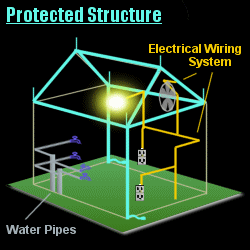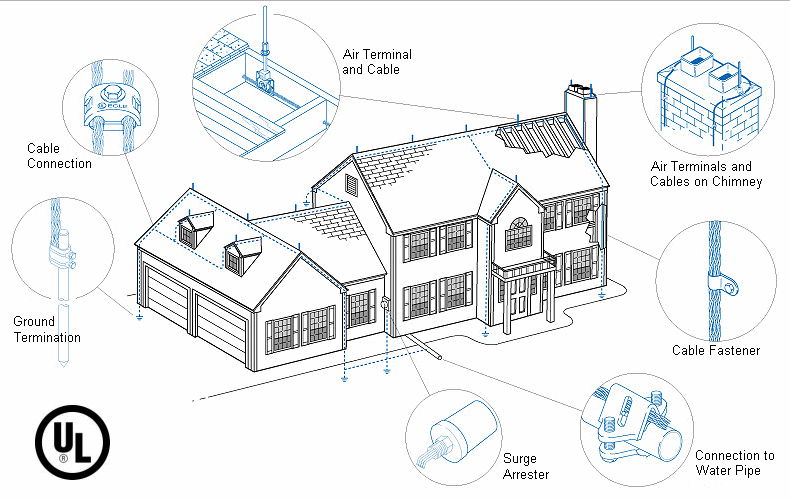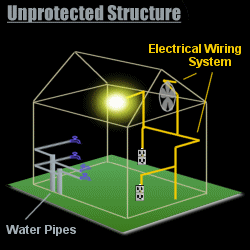Pride · Quality Products · Dependable Service
We take great pride in our company’s quality of workmanship and install systems to meet required codes of NFPA and UL96A, while maintaining the aesthetic features of your home, office or buildings.
Home Protection System includes:
- Minimum of two ground rods at least 10 feet deep
- Down conductors
- Air terminals spaced 20 feet apart along ridges and within two feet of ridge ends
- Roof projections such as weather vanes or ornamental points connected to system
- Air terminals located within two feet of outside corners of chimney
- Antenna mast connected to roof conductor
- Surge arrestor installed at electrical service panel to protect appliances
- Transient voltage surge suppressors installed in receptacles to which electronic equipment are connected
Commercial/Industrial Protection System includes:
- Ground rods at least 10 feet deep Down conductors
- Air terminals spaced 20 feet apart around the perimeter of the building
- Air handling units bonded to system (may need air terminals mounted on unit)
- Air terminals mounted within two feet of outside corners
- Mid-roof conductor and air terminals at maximum 50-foot spacing
- Grounded metal bodies into system
- Surge arrestors installed at main electrical panels
- Transient voltage surge suppressors installed in receptacles to which electronic equipment are connected
How a Residential Lightning Protection System Works
 A Lightning strike consists of opposite charges of electrical energy. Negative charges build up in the bottom part of the cloud closest to earth and positive charges build up directly underneath in the ground. Separating these two opposite charges is a non-conducting dry air belt. As the charges build up in intensity and the dry air belt becomes moist, lightning starts downward toward the earth in 150 foot jagged steps or intervals. The positive ground charge is attracted upward utilizing the lightning protection system as an outlet.
A Lightning strike consists of opposite charges of electrical energy. Negative charges build up in the bottom part of the cloud closest to earth and positive charges build up directly underneath in the ground. Separating these two opposite charges is a non-conducting dry air belt. As the charges build up in intensity and the dry air belt becomes moist, lightning starts downward toward the earth in 150 foot jagged steps or intervals. The positive ground charge is attracted upward utilizing the lightning protection system as an outlet.
As the negative leader stroke from the cloud continues toward the earth, the positive ground charge travels up through the lightning protection system and when the negative leader stroke is about 150 feet above the top of the protected building, the positive ground charge starts upward to meet and neutralize the downward leader stroke.
The two opposite charges are neutralized emptying the negative charge from the cloud and dissipating the ground charge. This all occurs in about 1/5000th of a second and the home, occupants and possessions are safe from the devastating effects of lightning.
If the residence had not been equipped with a lightning protection system, the positive ground charges would have accumulated under and within the house. The negative cloud charge would not have been neutralized 150 feet adove the residence and would have entered the building, causing possible fire, destruction, side flashes within the building, injury or even death. An average of 60 people are killed by lightning annually.
A diagram of a typical residential lightning protection system

Lightning presents several hazards including:
 Fire can start anywhere the exposed lightning channel contacts, penetrates or comes near flammable material (wood, paper, gas pipes, etc) in a building – including structural lumber or insulation inside walls and roofs. When lightning follows electrical wiring, it will often overheat or even vaporize the wires, creating a fire hazard anywhere along affected circuits.
Fire can start anywhere the exposed lightning channel contacts, penetrates or comes near flammable material (wood, paper, gas pipes, etc) in a building – including structural lumber or insulation inside walls and roofs. When lightning follows electrical wiring, it will often overheat or even vaporize the wires, creating a fire hazard anywhere along affected circuits.
Side flashes can jump across rooms, possibly injuring anyone who happens to be in the way. They can also ignite materials such as a gasoline can in a garage.
Damage to building materials – The explosive shock wave created by a lightning discharge can blow out sections of walls, fragment concrete and plaster, and shatter nearby glass.
Damage to appliances – Televisions, satellite recievers, DVD players, microwaves, phones, washers, lamps and just about anything plugged into an affected circuit may be damaged beyond repair. Electronic devices and computers are especially vulnerable.
